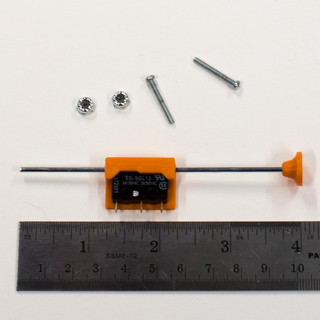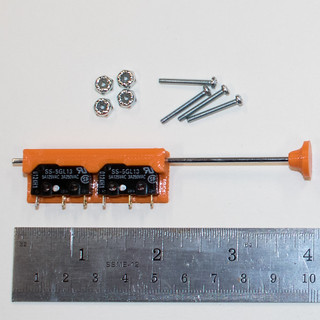You only need one switch per altimeter. I recommend putting that one switch between the battery and the altimeter because some altimeters include a continuity check on startup which would be fooled by having a switch between the altimeter and the ejection charge.
You must disarm all charges before lowering your rocket in case you have to remove it from the pad without launching it. That’s in NFPA 1127 which is central to the Safety Codes for both Tripoli and NAR. Be sure your design allows for that. Basically you just need to be able to turn the altimeter off (or in your current design interrupt the current that might flow to the ejection charge).
Steve Shannon
Sheeeeeeeeoooooot!!! Make doubly danged sure you switch off a Galejs MAD unit and let it sit 5 minutes (which I never do) 'cause I turn mine off and gently lift the nosecone and pull the ematch wire. Then it's safe. https://www.aeroconsystems.com/electronics/mad.htm
The Zeptomag unit ( I got a couple of 'em and can vouch for them) are safer https://www.tindie.com/products/ZeptoBit/zeptomag/ and I believe is the only commercially available one as Aerocon stopped selling the kits.
I killed one of mine with a homemade ematch and I'll be danged I found Dr. Galejs from the internet and he himself fixed mine when I sent it to him. Didn't ask for compensation but I dropped a 10 spot in the box.
I was funkily captivated testing the Galejs with an LED and watching it go on by tipping it over. The zeptomag has an onboard LED that will do that and it doesn't need any ematches wired in nor does power go to the terminals for testing. I checked it with
a meter. It activates by acclerometer. If you have a relatively low flier rocket that has the room a MAD unit is great for zipperless deployments. I do try to keep mine pointed straight up or just a hair downwind so if it weathercocks a bit the rocket flies a gentle curve to apogee (well that's what you try to do) for a low velocity deployment. I won't use a MAD with an RF tracker cause I don't want to be stuck testing like crazy to see if Rf dinks with the MAD device but I've flown 'em with the Jolly Logic chute release with no problems. The ASP large WAC Corporal comes with all the parts to make a forward ebay for a MAD unit: https://www.asp-rocketry.com/ecomme...ge-29-38-mm-Version-.cfm?item_id=631&parent=8
I love a two grain 38mm research H "ish" 160 motor I make and use a spring steel clip for retention. Hint: I don't "glue the coupler to the nosecone. I simply use flathead screws and mount the MAD on a piece 'o plywood all press fit. No worries about proper delay and if the rocket has a little more velocity than is desired, using the JLCR cuts down on deployment stress even if it's a bit fast with a nice lower main chute unfurling down lower.

This is an old picture after a chute tangle and the rocket took a hard hit. I did a coupler repair, repaint (nice job) and this was before the Jolly Logic Chute release was even on the scene. I had already removed the noscone off the
coupler assembly. Yes the ASP large WAC comes with that coupler and bulkhead for a "forward" stuffer tube. I thought it was ashame to have that wasted space in there glued to the nosecone and decided to stuff a MAD unit in there. The NC shoulder fits in the coupler tube and the coupler fits in the sustainer hence it can be secured with screws. I did a new harness and different chute protector and have more reliable flights with it now. I use only
one motor in it. My two grain research H160ish motor in an AT case. Gotta mix more of 'em up. Goes out of sight for a brief period if I don't use the longest delay grain (for smoke only) I can find. Kurt
Last edited:






